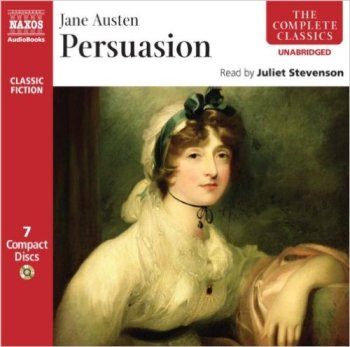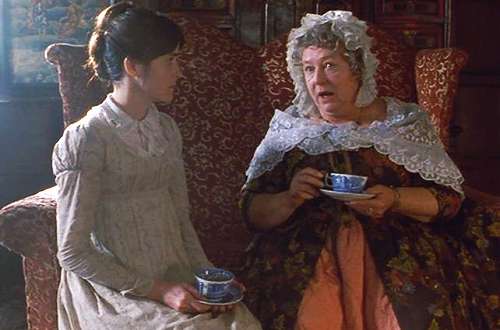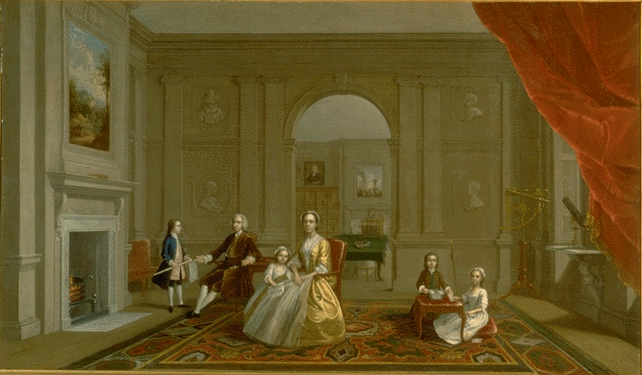Gentle Readers: I welcome today one of our JASNA-Vermont members, Heather Brothers, as she muses on a certain passage in “Persuasion” that she “discovered” during a recent re-listen. We’ve had a bit of an email discussion over this, so now want to it share with you and solicit your thoughts too.
The Musgrove’s Parlour
Several years ago I came upon the audio version of Persuasion as read by Juliet Stevenson. The manner of her reading infused more meaning into Persuasion than I ever picked up reading it myself. And through listening to this several times, I have noticed some fascinating passages that I would otherwise have overlooked. Here is one and I am happy to share others:
Anne Elliot and Mrs Musgrove: http://www.kellynch.com/Anne.php
Anne has arrived at Uppercross and is going to visit the Musgroves with Mary…
To the Great House accordingly they went, to sit the full half hour in the old-fashioned square parlour, with a small carpet and shining floor, to which the present daughters of the house were gradually giving the proper air of confusion by a grand piano forte and a harp, flower-stands and little tables placed in every direction. Oh! Could the originals of the portraits against the wainscot, could the gentleman in brown velvet and the ladies in blue satin have seen what was going on, have been conscious of such an overthrow of all order and neatness! The portraits themselves seemed to be staring in astonishment.
[Persuasion, Vol. I, Ch. 5]
******************
I have come to understand that Persuasion is written on the cusp of a new time period. Just before this passage above, Mr. and Mrs. Musgrove are described as representing the old ways and the two Miss Musgroves as the new ways. I get the impression that Jane Austen is using even the parlor in the Musgrove house as showing this change – that the minutia of interior design itself represents a change from the old ways to the new ways.
What was happening in interior design at this time? What architectural changes were taking place? I understand from fashion that ionic columns and flowing lines were the mode, but simplicity doesn’t seem to be the case with the Musgrove girls’ additions to the parlor. When I read this piece to my husband, who is an architect, he immediately got the impression that the girls were over-decorating; that they were building up the style to improve and impress.
This leads me to think that the astonishing overthrow of all order and neatness is both referring to the style of the room but also to the girls themselves. What would the portraits have thought of Henrietta and Louisa Musgrove in their endless pursuit of happiness, fun and excitement?
Seen in an earnest light, Henrietta and Louisa’s behavior is seriously flawed. Henrietta almost loses a good, stable life with a man she really likes and Louisa almost kills herself through taking their love-struck silliness to too high of a level. Did it all start in the parlor? Would the piano forte have been sufficient, but the additional harp, flower-stands and little tables represent the overthrow of moderation? Is Jane Austen’s commentary on the parlor a harbinger of what’s to come for these girls or for society?
If anyone can recommend books on this subject – please let me know!
********************
This portrait may serve as an example of what Jane Austen is referring to, hanging on the Musgrove parlor walls “against the wainscot,” where all is “order and neatness.”
1742-1743 the John Bacon family, by Arthur Devis
(Yale Center for British Art – New Haven, CT)
[Source: http://www.gogmsite.net/reign-of-louis-xv/1742-1743-john-bacon-family.html]
Austen packs into this one rather obscure sentence much about what is going on in the Musgrove household and the wider world! Thoughts anyone?
 Heather Brothers is one of our “Team of Janeites” in Vermont who helps with Hospitality and Boutique sales at our quarterly meetings. She is a young mother of two adorable girls, and also the author of a Regency-era novel, The Introduction of a Gentleman (2013) – it is a terrific read – you can find it on Amazon (and interesting to note that the cover depicts a young lady sitting at a pianoforte!)
Heather Brothers is one of our “Team of Janeites” in Vermont who helps with Hospitality and Boutique sales at our quarterly meetings. She is a young mother of two adorable girls, and also the author of a Regency-era novel, The Introduction of a Gentleman (2013) – it is a terrific read – you can find it on Amazon (and interesting to note that the cover depicts a young lady sitting at a pianoforte!)
Heather has also initiated at our meetings “The Awesome Austen Moment” – where we ask someone to read aloud a short passage from any of the Works, just to remind us all exactly what Austen could convey in any given sentence, this Persuasion piece a perfect example.
You can read more about Heather and her book here:
- An interview at JAIV: https://janeausteninvermont.wordpress.com/2014/01/14/the-introduction-of-a-gentleman-by-heather-brothers-author-interview-book-giveaway/
- The book is available at Amazon: http://www.amazon.com/The-Introduction-Gentleman-Heather-Brothers/dp/149272548X




Hi Heather. I have read your analysis of this passage. It is very good. I think it is just the thing Jane Austen would appreciate in her readers, an engagement with the details.. The reason I enjoy reading Jane Austen are just these human traits and quirks. Anne Elliot visits her friend Mrs Smith against her fathers wishes. She meets Captain Wentworth again after a lapse of years and they end up marrying. Persuasion is full of the realities of life.
LikeLike
Hi Tony, I agree – I really enjoy reading how Jane Austen describes the realities of life. And thank you so much for your post about visiting Chawton House Library.
LikeLike
I really like your analysis of this passage. I really enjoy listening to audio versions of jane austen books because I pick up on the humour and wit better than I would if I’d been reading it.
I think there is probably a lot of style in her writing that we don’t even get to appreciate because we aren’t familiar with the context. I always love when I find out something new!
LikeLike
I’ve been reading the annotated version of Persuasion that was published within the last few years – it’s been very helpful for giving context and information that I wouldn’t have picked up on.
LikeLike
Loved your post! Thank you for sharing your husband’s expert opinion. I think you’re on to something here. The cluttered parlour reminds me of the scene in Vol. II, chapter 2: riotous boys, a roaring Christmas fire, silk and gold paper, brawn and cold pies, and Mrs Musgrove raising her voice above the noise. ‘Nothing was likely to do her good as a little quiet cheerfulness at home.’ I may have got a bit carried away, but would the Musgroves be proto-Victorian in some sense?
LikeLike
I like that Christmas scene as well – so full of life. And it’s very funny how Lady Russell reacts to it, since she’s not used to being around kids:-) I’d have to learn more about the Victorian times to understand if they were looking forward to those times. Interesting thought.
LikeLike
Thought-provoking post, Heather! Persuasion is one of my very favorite books. I’ve read and listened to it (love audio books!) many times, especially in preparations for writing my novel The Persuasion of Miss Jane Austen. I’ve never read more into this passage than the typical exuberance of youth, which tends to throw a little chaos into every home. I assume it was the same then as now; teenagers are always trying to distinguish themselves from their parents, whom they consider old-fashioned, by doing things differently. I think JA was very fond of the Musgrove family and she means to depict this as a healthy, nurturing home, especially when laid out in direct contrast to the stuffy, stifling Elliot household.
LikeLike
Hi Shannon – I agree with you about Austen trying to show the startling difference between the Musgroves and the Elliots at home, all the more amusing because Mary makes such a fuss over being “higher” than those in the Great House. Do think that Heather has hit on an interesting piece that Austen expresses in that sentence – differences between the new and old ways of being, and such an perceptive way of telling it – comparing the current room of noise and confusion to the more formal portraits…Austen better at this than anyone.
Thank you for visiting Shannon!
LikeLiked by 1 person
I agree that she’s contrasting the two families, and I always feel sad for Anne when she has to leave Uppercross and go to Bath. Jane Austen describes Anne’s feelings so well in that section. Tell me about your book The Persuasion of Miss Jane Austen – what’s it about and what stage in the process are you in?
LikeLiked by 1 person
The Persuasion of Miss Jane Austen is finished and published, Heather. Thank you for asking. My best work to date, I believe, although not as popular as my P&P sequels. My theory is that JA wrote Persuasion as a veiled homage to her one true love, a sea captain of her own. I dearly wanted to give her romance and a plausible alternate outcome for her life. She deserved it! https://www.amazon.com/Persuasion-Miss-Jane-Austen-wherein-ebook/dp/B00MI5EWIQ/ref=pd_sim_351_4?ie=UTF8&dpID=51UXbeB-o5L&dpSrc=sims&preST=_OU01_AC_UL160_SR103%2C160_&refRID=X60V6WZSARS1CNMZTY4A
LikeLike
Thanks for sending the link – I look forward to reading your books!
LikeLiked by 1 person